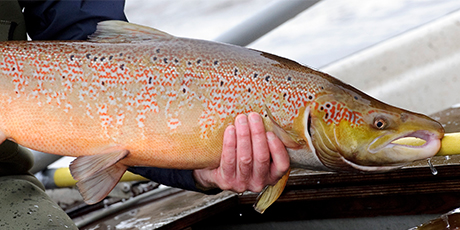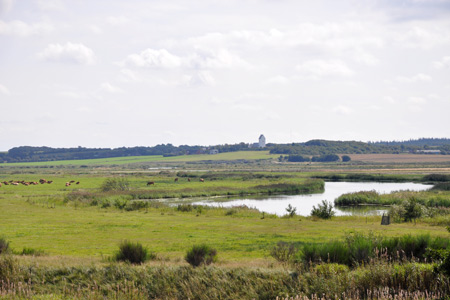By Mikkel Schnack Sørensen and Line Reeh
The last weeks of April are the peak season for salmon fishing in the Danish salmon streams, and the cottages by Skjern Å Camping are invaded by Danish, German, and Norwegian anglers. The reason is that while Europe is seeing a general decrease in salmon stocks, the Danish salmon stock has been growing for years. This has fostered an angling adventure boosting economic activity in local communities.
An analysis carried out by COWI, KORA, and DTU Aqua for the Danish Ministry of Food, Agriculture and Fisheries shows that the fishing in Skjern Å generates a local economic consumption of DKK 14.6 million a year and an annual added value of DKK 6.8 million. The analysis is financed by the fishcare management funding from the sale of fishing licenses.
Salmon in danger of extinction
The fact that it is even possible to catch salmon in Skjern Å today is attributable to a unique collaboration between researchers at DTU Aqua and local anglers. For many years, Skjern Å was not a particularly interesting location for salmon fishing. The stream had been straightened, and the salmon stock was small. In 2002, however, the winding courses of Skjern Å were restored, and major efforts have subsequently been made to improve spawning conditions for the salmon. As a result, the salmon stock has quadrupled from a little under 1,000 mature salmon in 2004 to approx. 4,000 today.
"The story of the Danish salmon is a success story—also internationally. The Danish management model for freshwater fish ensures close collaboration between users, authorities, and researchers—and it works," says Anders Koed, Head of Section and Acting Deputy Director of DTU Aqua.
As part of the management, a stream quota system has been implemented, and stock assessments are carried out regularly, as introducing quotas without knowing the size of the stock is impossible. Furthermore, targeted breeding programmes have been developed, and extensive restoration of the natural environment has taken place to safeguard salmon habitats.
|
Male salmon from Skjern Å. The Danish salmon can weigh up to 20 kg.
The number of wild salmon in Skjern Å has quadrupled compared to ten years ago. And the stock still has the potential to grow.
|
|
 |
Progress stagnated
Nevertheless, the Skjern Å salmon has not reached its full potential. DTU Aqua estimates that the stream system can sustain an increase of 6,000-12,000 spawning salmon on an annual basis.
"The salmon is an excellent environmental indicator—the salmon is a sign that streams are healthy and biologically well-functioning. But the life cycle of a salmon is complex and can easily be interrupted. Salmon stocks can be increased by improving their living conditions, for example by removing barriers to allow the salmon to migrate freely and by establishing spawning grounds.
The aim is for stocks to manage without releases.
Edited article from DYNAMO no. 41, DTU's quarterly magazine in Danish
 As early as the 1100s, the salmon was a very attractive and valuable fish. Back then, the king and the people with which he chose to share fishing rights took the much-coveted fish out of the stream in the so-called salmon weirs. When Frederick III started selling his property by Skjern Å in the 1660s, a 'salmon war' broke out where crownland peasants, squires, and locals fought over the desirable salmon fishing rights. Up until the early 1900s, salmon fishing was still flourishing, but overfishing and industrialization—including straightening of streams, poor water quality due to pollution, drainage, and dams for fish farming and hydroelectric power stations made life very difficult for the Danish salmon, and at the beginning of the 1990s, it was considered nearly extinct. Søren Larsen, a local angler and now fish farm manager at the Danish Centre for Wild Salmon, and Einar Eg Nielsen, a young researcher and now professor at DTU Aqua, joined forces and used brand new gene technology and DNA material from archived scale samples from salmon in the respective streams to demonstrate the survival of the original salmon. In 1993, the first book on rescuing salmon stocks through habitat restoration was released, and a systematic breeding and release programme according to modern genetic instructions was implemented.
As early as the 1100s, the salmon was a very attractive and valuable fish. Back then, the king and the people with which he chose to share fishing rights took the much-coveted fish out of the stream in the so-called salmon weirs. When Frederick III started selling his property by Skjern Å in the 1660s, a 'salmon war' broke out where crownland peasants, squires, and locals fought over the desirable salmon fishing rights. Up until the early 1900s, salmon fishing was still flourishing, but overfishing and industrialization—including straightening of streams, poor water quality due to pollution, drainage, and dams for fish farming and hydroelectric power stations made life very difficult for the Danish salmon, and at the beginning of the 1990s, it was considered nearly extinct. Søren Larsen, a local angler and now fish farm manager at the Danish Centre for Wild Salmon, and Einar Eg Nielsen, a young researcher and now professor at DTU Aqua, joined forces and used brand new gene technology and DNA material from archived scale samples from salmon in the respective streams to demonstrate the survival of the original salmon. In 1993, the first book on rescuing salmon stocks through habitat restoration was released, and a systematic breeding and release programme according to modern genetic instructions was implemented.